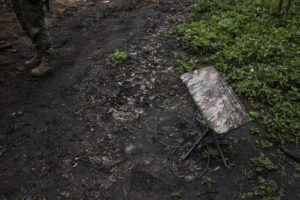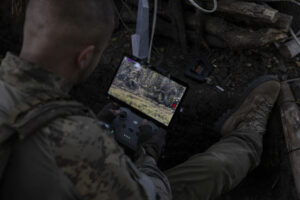SEPTEMBER 8, 2023

DNIPRO, Ukraine — New details about how Elon Musk limited Starlink satellite internet service to prevent Ukraine from attacking Russian ships in Crimea last year have provided a stark reminder of how vital the service is to Kyiv’s forces — and how success on the battlefield depends partly on the whims of a mercurial billionaire.
Musk’s company SpaceX dispatched Starlink terminals to Ukraine after Russia’s invasion in February 2022, when Moscow quickly cut off all other service. Ever since, the high-speed satellite terminals have formed the backbone of the Ukrainian military’s digital communications. Nestled into trenches, covered in camouflage atop armored vehicles and humming in dusty command centers, the small WiFi terminals are so essential many soldiers say not having them would put their lives at risk.
Modern war zones are awash in digital communication, requiring fast, secure internet. In Ukraine, Starlink’s data stream helps pipe in drone feeds from across the battlefield, allowing commanders to view enemy forces in real time and coordinate artillery strikes much faster than relaying the same information over radios.
There are some 42,000 Starlink terminals in Ukraine, officials have said, which provide military, government and civilian communications as Russia relentlessly attacks civilian infrastructure. The terminals are also playing an increasingly important role in Ukraine’s counteroffensive, giving soldiers portable communication options in rural areas along the southern front that are either too remote or where cellular towers have been damaged and destroyed.
The terminals also provide connectivity for smartphones and tablets, which do everything from helping soldiers stay updated in group chats to running apps that help compute targeting information for howitzer batteries. Soldiers often use the same Starlink-connected devices to communicate with loved ones back home or abroad and to upload battlefield videos onto social media.

A Starlink terminal is positioned outside a Ukrainian base in Bakhmut district in April. (Ed Ram for TWP)
In a recent operation in the northeast Luhansk region near Russian lines, a Starlink terminal pumped WiFi data for a three-man attack drone team, allowing the pilot to monitor a group chat providing real-time updates on enemy locations and movements. Victor Stelmakh, the head of an attack drone unit in the 68th Jaeger Brigade, used that information to deploy several drones and drop grenades on enemy positions. The strikes, which were observed by Washington Post reporters, wounded several Russian soldiers.
The details about Musk’s role in limiting Starlink service are included in a new biography of the billionaire businessman by Walter Isaacson. An excerpt of the book was published in a Washington Post opinion article. The details from the book about Musk’s role in cutting off Starlink were first reported by CNN.
The revelations in Isaacson’s book have reignited concerns about the influence that SpaceX and Musk, as its owner, wield over the war in Ukraine.
In October 2022, armed sea drones were poised to attack the Russian fleet, according to the biography. Instead, the drones “lost connectivity and washed ashore harmlessly” because Musk secretly ordered engineers to suspend Starlink service near occupied Crimea, the Ukrainian peninsula that Russia illegally invaded and annexed in 2014.
Ukrainian and U.S. officials scrambled to get service restored, according to the book, appealing to Musk directly. Musk eventually agreed. “There was an emergency request from government authorities to activate Starlink all the way to Sevastopol,” Musk said Friday on X, the company he owns formerly known as Twitter. He was referring to the Crimean port city that has long been the headquarters of Russia’s Black Sea Fleet. Russia maintained the headquarters under a lease agreement with Ukraine after the collapse of the Soviet Union.
In a conversation with Isaacson, Musk expressed reluctance that his service be used for such an attack. “The obvious intent being to sink most of the Russian fleet at anchor,” Musk told Isaacson. “If I had agreed to their request, then SpaceX would be explicitly complicit in a major act of war and conflict escalation.”

Victor Stelmakh, head of an attack drone unit in the 68th Jaeger Brigade, rests a Starlink-connected phone on his body armor to communicate with soldiers while piloting a drone in the Luhansk region on Sept. 1. (Heidi Levine for TWP)
SpaceX did not return a request for comment. Ukrainian officials note that Russia’s invasion of Crimea in 2014 and of the entirety of Ukraine in 2022 were illegal acts of aggression and alleged war crimes under international law.
On Thursday, Mykhailo Podolyak, an adviser to Ukrainian President Volodymyr Zelensky, said Musk’s decision to sever Starlink service near Crimea and other occupied territories of Ukraine had resulted in the deaths of civilians.
“As a result, civilians, children are being killed,” Podolyak posted on X.
“This is the price of a cocktail of ignorance and big ego,” Podolyak continued. “However, the question still remains: Why do some people so desperately want to defend war criminals and their desire to commit murder? And do they now realize that they are committing evil and encouraging evil?”
Ukraine’s minister of digital transformation, Mykhailo Fedorov, whose ministry deals directly with Starlink, did not respond to a request for comment.
Musk’s ability to control Ukrainian military operations have alarmed some corners of the Pentagon, which has sent billions of dollars in weapons to help Ukraine defend against the Russian invasion. The Defense Department has struggled to rein him in, though it has agreed to foot costly Starlink service bills following threats from Musk that he would stop providing the service free.
Ukrainian troops have integrated Starlink into every corner of the conflict, relying on the service for virtually any task that requires digital communication.
An air reconnaissance soldier with the call sign Labrador, using the gaming term “IMBA,” or imbalance, said Starlink offers a significant advantage over Russian capabilities. Multiple drone feeds on a single screen provide commanders and scouts with situational awareness, Labrador said. Surveillance drones watching artillery fire can send fast and precise impact locations, he said, allowing howitzer crews to quickly adjust their aim and hit a target.
Labrador, as other soldiers, spoke on the condition that he be identified only by his call sign in keeping with Ukrainian military rules.
Losing Starlink, he said, would force Ukraine to fall back on more traditional communications such as radio or other inferior alternatives. It could be done, he said, but it would require difficult trade-offs. For instance, he said, where digital communication is used between trenches, soldiers might have to leave relative safety to pass on information orally.
“These are additional risks,” he said. “It can be said that the lack of an alternative to Starlink will increase the level of mortality and injuries.”
Internet access through Starlink has also helped soldiers when they need to access training manuals and get more information about the advanced weapons and equipment they have received from the West, said Rusyn, the deputy commander for the Carpathian Sich 49th infantry battalion.
“If they stopped working at some point, it wouldn’t be the end of the world,” Rusyn said, “but it would significantly worsen our situation at the front, our effectiveness.”
Starlink provides a crucially important lifeline for civilians too.
A year ago, after a surprise Ukrainian advance liberated swaths of territory in the country’s northeast, civilians emerged from a Russia-controlled information bubble. For months, with most cell and internet service cut, they had been unable to connect with loved ones elsewhere in Ukraine. And even for days after cities and towns came back under Ukrainian control, some were unable to contact their families to confirm they had survived.
In Izyum, for example, when Ukrainian soldiers set up base in town and hooked up their Starlink — slightly damaged from a previous shelling — locals gathered around to connect to the network and speak to relatives, sometimes for the first time since the early days of Russia’s invasion in February 2022.
Journalists covering the war also routinely use Starlink as the only way to send news reports, images and video from areas that otherwise do not have functioning internet service.
The Ukrainian use of Starlink has drawn a strong response from Moscow, including experimentation with secretive electronic warfare capabilities intended to neutralize the service, according to leaked U.S. intelligence assessments obtained by The Washington Post.
The Russian military for months tested ways to disrupt communication links over Ukraine, the classified documents said, but the documents did not conclude whether the tests were successful or had their intended effect.

































































































